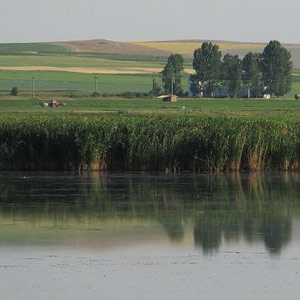Magazine | Voyages
Le delta du Danube et la Dobroudja (Roumanie) du 27 juillet au 14 août 2003

Vue du lac Razim, qui s’étend au sud du delta du Danube (Roumanie).Source : Wikimapia.org
Introduction
Une visite de la Roumanie orientale (delta du Danube et Dobrudja) constitue souvent un must pour l’observateur européen. En effet, le delta, classé réserve de la biosphère, rivalise avec le parc national de Coto Doñana en Espagne et la Camargue en France parmi les zones humides les plus riches d’Europe. Au sud de ce vaste ensemble de roselières et de canaux s’étend la Dobroudja, une région bordant la Mer Noire et offrant une grande variété d’habitats et d’espèces.
Deux observateurs suisses, Samuel Progin et Romain Béguelin, du Groupe des Jeunes de Nos Oiseaux (association ornithologique de Suisse romande) y ont séjourné du 27 juillet au 14 août 2003, et ils nous ont communiqué des photos et la liste de leurs observations.
Abstract
Ranking alongside Donana and the Camargue as Europe’s top wetland birding sites, the Danube Delta, a Biosphere Reserve, is a vast area of marshes, lakes and islands, swamps, wet forests and reedbeds on the Black Sea coast of Romania. The delta is a mosaic of freshwater and widths, and with high, thick reedbeds. Indeed, the Danube Delta’s reedbeds constitute the largest expanse in the world covering 2,700 square km. More than 170 bird species are regular breeders here and among the many exciting breeders are both pelicans, Pygmy Cormorant, a variety of herons and egrets, Glossy Ibis, Ferruginous Duck or White-tailed Eagle. If all this were not enough there is also, in addition to the delta proper around 880 square km of lagoons saltmarsh, sandy and shingle beaches and other coastal habitats to the immediate south in the vast Razelm-Sinoie lagoon complex.
And beyond the la goons is the coastal plain of Dobrudja. This largely dry region extends from the River Danube as it flows from south to north before forming the delta and the lagoons and Black Sea to the east. The landscape is typically formed by rolling steppe and fields dotted with woodlands, brackish and fresh water lakes. Many of the birds that breed in the delta can also be found there, and some others such as the Red-breasted Goose (winter), the Levant Sparrowhawk, the Collared Pratincole, the Pied Wheatear, the Calandra Lark and the Spanish Sparrow are easier to find.
Two Swiss birders, Samuel Progin and Romain Béguelin, members of the Groupe des Jeunes de Nos Oiseaux, visited this area from the 27th of July to the 14th of August 2003, and they sent us their report.
Poursuivez la lecture de cet article, en vous abonnant dès maintenant !
Découvrez les Archives d’Ornithomedia.com
Pour seulement 10,00 €TTC/an (ou 6,00 € les 6 mois)
Profitez de plusieurs centaines d’articles en accès illimité et sans aucun engagement.
Compléments
Auteurs
Romain Béguelin et Samuel Progin
À lire aussi sur Ornithomedia.com
- À la découverte du parc naturel de Vânatori-Neamt (Roumanie)
- Observer les oiseaux à Vienne
- Séjour ornithologique en Hongrie du 11 au 22 mai 2005
- Trois bons secteurs dans les plaines slovaques
Ouvrages recommandés
- Le guide Ornitho de L. Svensson et al
- Carte routière : Roumanie de Cartes Europe IGN
- Finding Birds in Romania de Dave Gosney




Aucun commentaire sur ce sujet
Participer à la discussion !